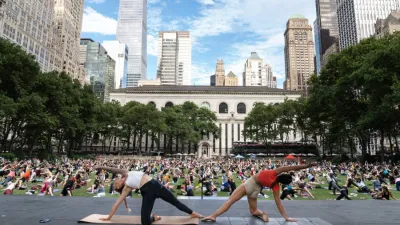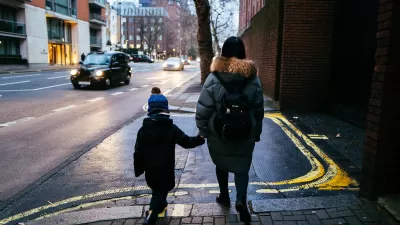Dr. Lawrence Frank (U. of British Columbia) et.al. looked at Atlanta to make the connection between health reform and transportation reform, devising a clever 'energy index'. While the index rose in denser neighborhoods, it didn't in mixed-use ones.
The results of the survey were surprising. Density without mixed use produced greater amounts of walking and biking than those with mixed use.
"Frank, Steve Winkelman of D.C.'s Center for Clean Air Policy, and Michael Greenwald of the Seattle-based firm Urban Design 4 Health used data from Atlanta's SMARTRAQ survey to map the amount of calories burned by various blends of walking, transit, and car use. That calorie-burning factor was dubbed the "energy index."
The "energy index" of Atlantans increased significantly as their neighborhoods grew denser, according to the study, and the number of calories they used on motorized travel shrank in denser, more walkable areas...In neighborhoods where mixed-use development grew, bringing housing closer to commercial property, the energy used for driving and walking decreased, leaving Atlantans' "energy index" unaffected."
"This result likely demonstrates that the energy required to travel in a very mixed land use pattern is lower for both walking and driving - with no real impact on the relationship between the two modes," the study's authors wrote.
From Streetsblog, Transportation Reform Is Health Reform:
"For every long-term $1 increase in gas prices, the national obesity rate drops by 10 percent, according to Courtemanche. That relationship goes a long way towards explaining why the House and Senate health care bills include "community transformation" grants to entice cities and towns into building bike paths, playgrounds, and other pedestrian-friendly improvements."
Thanks to Catherine Cecchi
FULL STORY: Study: Even in Car-Centric Atlanta, Transport Reform is Health Reform

Maui's Vacation Rental Debate Turns Ugly
Verbal attacks, misinformation campaigns and fistfights plague a high-stakes debate to convert thousands of vacation rentals into long-term housing.

Planetizen Federal Action Tracker
A weekly monitor of how Trump’s orders and actions are impacting planners and planning in America.

In Urban Planning, AI Prompting Could be the New Design Thinking
Creativity has long been key to great urban design. What if we see AI as our new creative partner?

Cal Fire Chatbot Fails to Answer Basic Questions
An AI chatbot designed to provide information about wildfires can’t answer questions about evacuation orders, among other problems.

What Happens if Trump Kills Section 8?
The Trump admin aims to slash federal rental aid by nearly half and shift distribution to states. Experts warn this could spike homelessness and destabilize communities nationwide.

Sean Duffy Targets Rainbow Crosswalks in Road Safety Efforts
Despite evidence that colorful crosswalks actually improve intersection safety — and the lack of almost any crosswalks at all on the nation’s most dangerous arterial roads — U.S. Transportation Secretary Duffy is calling on states to remove them.
Urban Design for Planners 1: Software Tools
This six-course series explores essential urban design concepts using open source software and equips planners with the tools they need to participate fully in the urban design process.
Planning for Universal Design
Learn the tools for implementing Universal Design in planning regulations.
Appalachian Highlands Housing Partners
Gallatin County Department of Planning & Community Development
Heyer Gruel & Associates PA
Mpact (founded as Rail~Volution)
City of Camden Redevelopment Agency
City of Astoria
City of Portland
City of Laramie




























